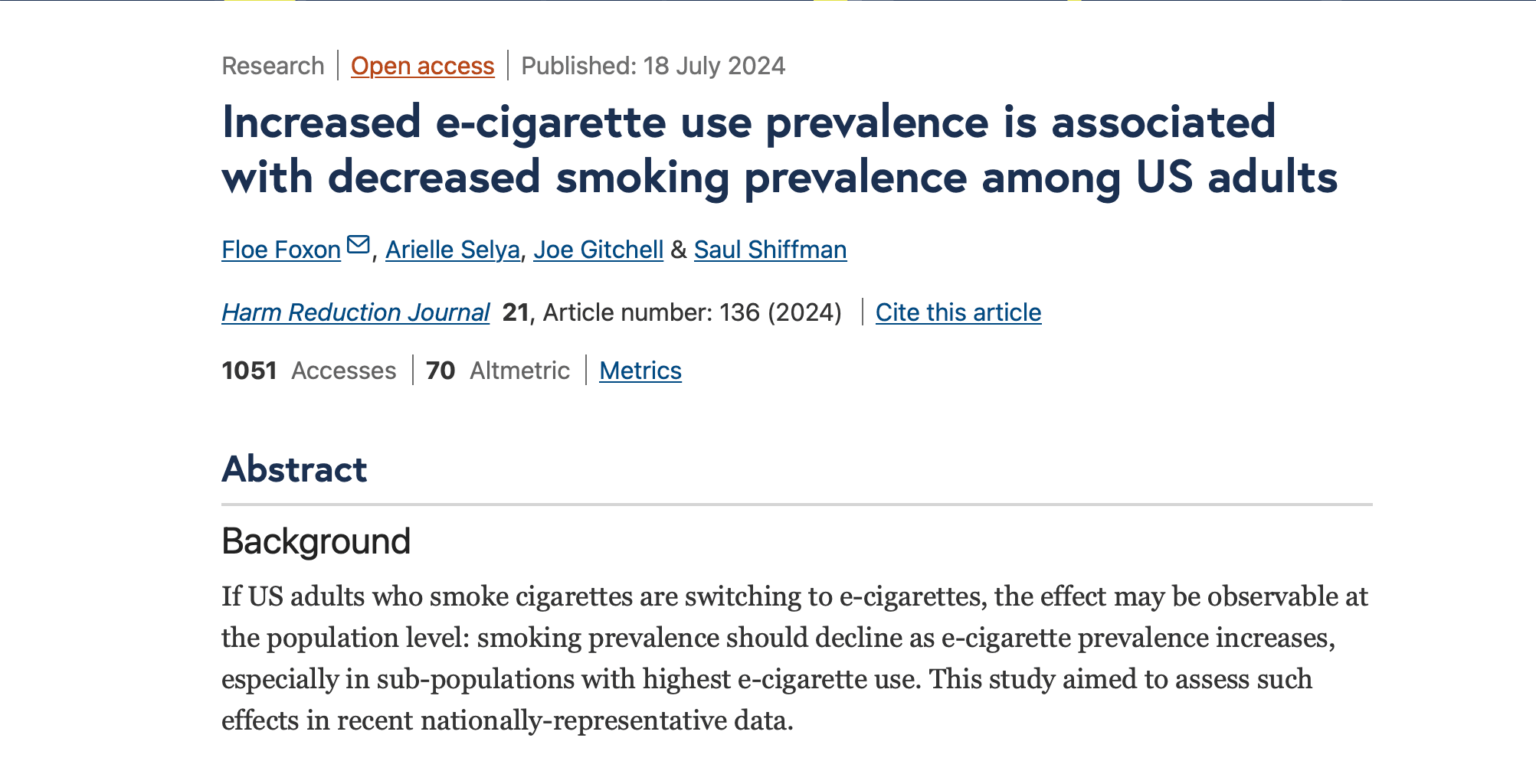A new analysis conducted on the latest available National Health Interview Survey data through 2022 showed that population-level data suggest that smoking prevalence has declined at an accelerated rate in the last decade in ways correlated with increased uptake of ecig use.
Since their market introduction, the question of whether combustion-free products could be a useful tool in the fight against cigarette smoking or simply a substitute has divided the scientific community. Over the years, technological innovation and the development of various products on the market have modified the health risk parameters related to the use of these tools, creating the basis for a redefinition of public health policies.
To date, the phenomenon of ecig use is at the center of scientific debate: both for adult smokers who cannot quit and see these products as a way to reduce exposure to toxic substances released by cigarette smoke, and for the concern over use by at-risk groups, such as younger individuals. Many experts believe that vaping represents a kind of gateway to the world of smoking: evidence for the ‘gateway’ effect has not been detected in population-level studies on the prevalence of e-cigarette use and smoking among young people; indeed, smoking prevalence remains at an all-time low among US adolescents and young adults, despite increases in e-cigarette use.
The new analysis “Increased e-cigarette use prevalence is associated with decreased smoking prevalence among US adults” published in the Harm Reduction Journal is an update on a previous analysis modeling population-level prevalence that assessed whether and how much the introduction of e-cigarettes in the US may be correlated with declining smoking prevalence among populations of US adults using the National Health Interview Survey (NHIS) .
Results showed that population-level data continue to suggest that smoking prevalence has declined at an accelerated rate in the last decade in ways correlated with increased uptake of e-cigarette use.
“We found that as ecig use increases at the population level, smoking prevalence tends to decrease, which is what you’d expect to observe if e-cigarettes were used as an alternative to cigarette smoking in the real world” explains Floe Foxon, Pinney Associates researcher and author of the analysis. “We also found that this possible substitution between e-cigarette use and smoking was most pronounced in groups that used e-cigarettes the most, which again would be expected if e-cigarettes were being used instead of cigarettes. While it is important to note that the study does not infer causality and that these methods have limitations noted in the paper, they do appear to support a growing body of literature including other simulation studies, econometric research, and randomized controlled controls which suggest that e-cigarettes substitute for cigarettes among adults”.
The study was conducted to evaluate these hypotheses: “If e-cigarettes are a ‘gateway’ to cigarette smoking, then at the population level, as ecig use prevalence increases, we would expect to see an increase in smoking prevalence also, or at least a slowing of the rate of decline of smoking prevalence. Conversely, if e-cigarettes help people who smoke to switch away from smoking and/or if they divert people away from starting smoking in the first place, we would expect to see the opposite, that as e-cigarette use increases, smoking prevalence decreases in ways correlated with e-cigarette use. In the real world, there may be a combination of these two pathways. The purpose of this study was to determine whether there is evidence for either pathway using nationally representative population-level prevalence data among US adults aged 18+.”
Researchers considered a range of ‘cut-off’ years to mark the onset of a time when e-cigarette use could have materially affected smoking prevalence, from 2006 (the year before e-cigarettes entered the US market) to 2011 (the year after the Affordable Care Act of 2010).
“The results of the study were consistent across this range of ‘cut-off’ years, which suggests that the findings are not simply an artifact of this methodological consideration. Importantly, we also found that the observed declines in smoking prevalence were too big to be explained by the Tobacco Control Act and the Tips campaign from the Affordable Care Act, suggesting that those two interventions alone cannot explain how much smoking prevalence has fallen in the last decade, leaving room for other potential contributing factors such as e-cigarettes, which we found to be highly correlated with smoking declines.”
Data suggest that the adoption of e-cigarettes is uneven across demographics: “For example, e-cigarette uptake is much greater among younger adults compared to older adults, and it is among younger adults that smoking has declined the most. We saw other differences by race/ethnicity and by sex. Policymakers should consider these factors when deciding how best to regulate e-cigarettes to ensure no demographic is ‘left behind”.
“We hope that policy makers consider these findings as part of the weight of evidence for regulation of nicotine products. The totality of evidence for the potential costs and potential benefits of nicotine in potentially less harmful forms is what public health bodies should consider when confronting the need to regulate these products in such a way that is appropriate for the protection of public health”.
To conclude, there are several limitations to consider: this study is ecological using cross-sectional data; therefore, causality cannot be established on these findings alone. Cross-sectional data also have selection and response bias, which may limit the accuracy of prevalence point estimates. Due to limitations in the questionnaire design of NHIS, the temporal ordering of product use (i.e., e-cigarettes being used before or after cigarette smoking) cannot be ascertained. As noted, there were some changes to survey methodology over time (accounted for by sensitivity testing). The authors consult for Juul Labs on tobacco harm reduction.




